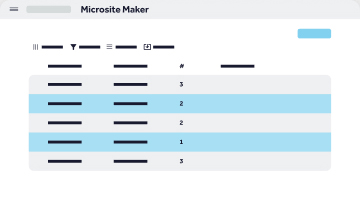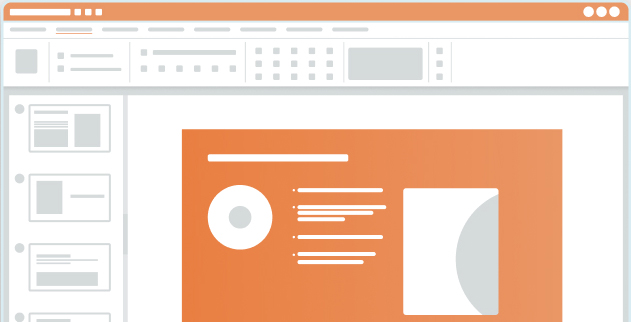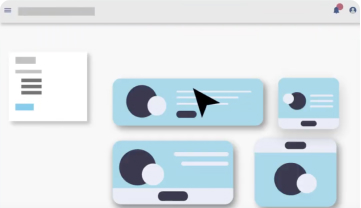The floor of a major healthcare conference is a unique environment. It is a mix of high-stakes science, intense networking, and sensory overload. Whether you are at HIMSS, ViVE, or a specialized medical symposium, your sales and field marketing teams are having dozens of critical conversations every single hour.
In this environment, the goal isn’t just to make contact; it’s to make the connection stick.
When a prospect – whether a hospital administrator or a specialized HCP – walks away from your booth, the clock starts ticking. How do you bridge the gap between that handshake and the follow-up meeting? How do you deliver complex clinical information without weighing them down with physical binders?
For forward-thinking enterprise teams, the answer is the microsite.
A “microsite for events” acts as a digital concierge. It is a standalone, focused web experience designed specifically for that campaign, that audience, and that moment in time. It bridges the physical and digital worlds, ensuring that the momentum you build on the trade show floor continues long after the prospect heads back to their hotel room.
Here are 5 strategic reasons why a dedicated microsite should be the cornerstone of your next event strategy.
1. A Microsite for Events Creates a Hyper-Relevant Experience
Context is the currency of modern marketing. When a prospect meets your team at a specific event, they are in a specific mindset. They are focused on the themes of that conference – be it interoperability, a specific therapeutic area, or new regulatory standards.
If you direct that prospect to your general corporate homepage, you are forcing them to code-switch. Suddenly, they are bombarded with your full navigation bar: Investor Relations, Careers, General News, and product lines that have nothing to do with the conversation you just had. You are asking them to do the work of finding the relevant information.
This is a mistake. According to McKinsey, 71% of consumers expect companies to deliver personalized interactions, and they get frustrated when this doesn’t happen.
A dedicated event microsite gives them that specific, relevant experience.
When they scan a QR code or visit the link, they land on a page that welcomes them to that specific event. It speaks the language of the conference. It highlights only the solutions you are showcasing at the booth. It creates a seamless narrative thread from the physical signage in your booth to the screen on their mobile device.
Why this matters for Healthcare:
In healthcare, relevance is often a matter of compliance and audience segmentation. If you are at a cardiology conference, directing an HCP to a general page that includes orthopedics or patient-facing materials can be distracting and dilute your message. A microsite ensures the digital experience mirrors the physical one: focused, expert, and relevant.
2. A Microsite Allows for Richer Storytelling (Because You Have Less Time Than You Think)
A conversation at a booth is often brief. You might have five minutes to pitch a complex medical device or a new pharmaceutical formulation. You can spark interest, but you rarely have time to dive into the deep technical weeds that actually drive the purchasing decision.
Furthermore, the modern B2B buyer is spending less time with you than ever before. Gartner reports that B2B buyers spend only 17% of the total buying journey meeting with potential suppliers. The vast majority of their decision-making process happens independently, researching online.
This is where the microsite shines as a “content container.”
Unlike a printed one-pager, which has finite real estate, a microsite allows you to curate a deep library of assets that the prospect can explore at their own pace. You can house:
- Full Clinical Study PDFs: Allow HCPs to download the raw data without needing to email it.
- Video Demonstrations: Host a 3-minute product tour or a KOL (Key Opinion Leader) interview that reinforces the pitch you just made.
- Executive Bios: Let the prospect read up on the leadership team present at the event.
- Interactive Data: Use simple visualizations to show patient outcomes or ROI calculators.
By having these assets ready on a microsite, your sales team can say, “I know you have to run to the next session, but scan this. It has the full clinical breakdown and a video of the mechanism of action that you can watch later.”
The Result: You turn a fleeting interaction into an opportunity for the prospect to “binge-watch” your content on their flight home, effectively capturing that 83% of the buying journey where you aren’t in the room.
3. Microsites Keep Your Team Compliant
In the pharmaceutical, insurance, and financial industries, “going rogue” is a constant fear.
Field marketing and sales teams are under immense pressure to be agile. If they don’t have the right materials, they might be tempted to create their own slides or print out older versions of a brochure. In regulated industries, this isn’t just a branding error – it’s a legal risk. Using a document with an expired claim or missing Important Safety Information (ISI) can lead to significant fines.
A centralized event microsite solves the “version control” nightmare.
Think of the microsite as a “single source of truth.” The marketing and legal teams at headquarters approve the content on the site. The sales reps on the floor simply share the link.
- If a disclaimer needs to be updated mid-event? Marketing updates it on the backend, and it instantly reflects on everyone’s device.
- If a product indication changes? It is corrected globally in seconds.
This gives your sales team confidence. They don’t have to worry if the PDF on their iPad is the correct version. They know that the microsite is the “safe zone” – always approved, always on-brand, and always compliant.
4. Microsites Offers Real-Time Agility
Events are dynamic, living things. The conversation on Day 3 often looks very different from the conversation on Day 1.
Perhaps a competitor makes a surprise announcement during the keynote, and your booth is suddenly flooded with questions about how your solution compares. Or, perhaps you realize that attendees are confused about a specific feature of your product.
If you rely solely on printed materials, you are stuck. You cannot edit a brochure that was printed three weeks ago.
However, a microsite gives you agility.
Because the asset is digital, your marketing team can react to the pulse of the event in real-time.
- Tuesday Morning: You notice a trend in questions at the booth.
- Tuesday Lunch: Marketing drafts a new “Frequently Asked Questions” section or uploads a comparison sheet.
- Tuesday Afternoon: The microsite is updated, and sales reps are using the new asset to win arguments on the floor.
This ability to pivot – to meet the “Tuesday needs” of the sales team without a six-week lead time – is a massive competitive advantage. It shows your market that you are listening and that you are responsive.
5. A Microsite Provides Actionable Data for Follow-Up
The “business card fishbowl” is a black hole for data.
When you collect a physical business card or scan a badge, you know who stopped by, but you rarely know what they care about. Did they want a demo? Were they just being polite? Are they interested in Product A or Product B?
Usually, sales teams follow up with a generic, “Great to meet you!” email that gets ignored.
A microsite changes the game by generating intent data. By using a platform that tracks engagement, you can see exactly how a prospect interacted with your digital leave-behind.
- Prospect A visited the site, stayed for 10 seconds, and left. (Low Priority).
- Prospect B visited the site, watched the “Mechanism of Action” video twice, and downloaded the “pricing structure” PDF. (High Priority).
According to Content Marketing Institute’s latest research, understanding which content assets perform best is a top priority for B2B marketers. This data allows your sales team to segment their follow-up. Instead of a generic email, they can write to Prospect B: “I saw you were looking at the pricing structure and the clinical video – do you have time this week to discuss how those apply to your specific hospital system?”
The microsite transforms the follow-up from a cold outreach into a continuation of the digital conversation.
The Takeaway: Professional, Polished, and Practical
For too long, creating a dedicated website for a single event felt like an impossible luxury for enterprise teams. The traditional web development process – involving IT tickets, wireframes, and coding – was simply too slow and expensive for a three-day conference.
But the landscape has changed.
You no longer need a team of developers to launch a professional, compliant digital experience. You just need the right infrastructure.
By moving your event strategy to a microsite-first approach, you empower your sales team to travel lighter, move faster, and close deals with the confidence that they have the full weight of the marketing team right in their pocket.
Ready to build your next event microsite in minutes, not months?
Talk to our team and see how easy it is to keep your organization on-brand and on-message, no matter where the event takes them.




